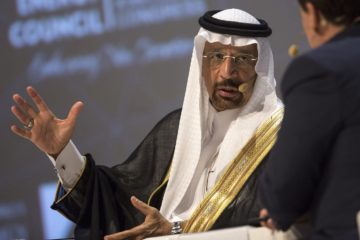Surprise Oil Price Cut Shows Saudis Fending Off Sweet U.S. Flood

published Mar 6th 2017, 4:51 pm, by Serene Cheong and Sharon Cho
(Bloomberg) —
The oil is light, sweet and tempting, with a lot of it made in the U.S. Saudi Arabia’s trying to keep it away from the biggest crude buyers.
The Middle East producer cut the pricing for some of its April oil sales to Asia, surprising customers who were expecting an increase that was signaled by the structure of the market. That shows it’s trying to lure buyers toward its lighter and less sulfurous crude varieties at a time when similar-quality grades are rushing to the region from the Americas, Europe and Africa.
‘Sweet’ crudes with less sulfur are typically costlier than dirtier ‘sour’ oils because they can be more easily processed into valuable products such as gasoline. With its latest pricing, the premium of one of Saudi Arabia’s lightest grades to its heaviest has shrunk to the smallest since July 2015. This is the producer’s latest effort to defend sales in Asia — a region that’s already largely spared from its output curbs — as Middle East prices strengthen and make supply from elsewhere relatively cheaper.
“This came as a complete surprise to the market,” said Tushar Tarun Bansal, director at industry consultant Ivy Global Energy in Singapore, referring to the Saudi pricing cut. “This is a signal from the Saudis that they are serious about market share and pricing crude competitively, and would even be open to changing the methodology if the need arises.”
The world’s biggest crude exporter cut the official selling price for its Arab Light crude to Asia by 30 cents to 15 cents a barrel below the regional benchmark for April. Refiners and traders had expected state-run Saudi Arabian Oil Co. to set pricing at 30 cents more than the marker. It was the first time in at least a year that the grade was set at a discount when buyers were predicting a premium, data compiled by Bloomberg show.
The company known as Saudi Aramco also cut April pricing for Asia from a month earlier for Extra Light crude by 75 cents and Super Light by 50 cents a barrel. The Medium grade was reduced by 30 cents while Arab Heavy was left unchanged. In other regions, Heavy crude for the Mediterranean was the only grade for which pricing was increased.
The bigger reductions for lighter varieties don’t mean the company isn’t facing competition in sales of heavier grades. Some sour supplies that have rarely or never-before come to Asia have recently been flowing to the region, but are still relatively sporadic.
For more on unusual oil supplies arriving in Asia, click here
Light, sweet crude, like that which is produced in American shale fields and Europe’s North Sea, pose the bigger threat. While Saudi Arabia leads output cuts as part of a deal between OPEC and other nations to erode a global glut, supplies are ramping up in regions such as the U.S. where producers aren’t part of the agreement. That’s boosted Middle East benchmark Dubai crude relative to other markers such as U.S. West Texas Intermediate and Brent.
For a story on how OPEC’s cuts have cleared the way for U.S. oil to Asia, click here
“The tightness in the crude market now is clearly in medium and heavy sour grades, not in lights,” said Amrita Sen, chief oil analyst at Energy Aspects in London. “Part of that is clearly to do with the U.S., and rising U.S. exports, much of which is headed to Asia in February.”
West African producers last month were expected to send the most crude to Asia in at least five years while unprecedented flows of North Sea oil were bound east earlier this year. Eagle Ford shale and West Texas Intermediate are among U.S. oils that have recently made their way to Asia.
The flow of cargoes from the west meant there “were competitive pressures,” Ivy Global’s Bansal said. “However, this has been a case in the past but Saudis have always stuck to their pricing methodology.” While the latest cut doesn’t mean the Middle East producer has completely moved away from its traditional pricing method, “a change happening will not be seen as impossible now,” he said.
Apart from its pricing strategy, Saudi Arabia has also sought to defend market share via output tactics. In January, people with knowledge of the matter said it’s continuing to pump lighter oil while fulfilling its promise to cut output by focusing curbs on medium and heavy varieties.
The Saudis are “facing more competition at the light barrels side,” said Peter Lee, an analyst at BMI Research. “Because they’re already cutting production from the medium to heavy barrels side, the Saudis would hate to lose further market share in the light side of things.”
To contact the reporters on this story: Serene Cheong in Singapore at scheong20@bloomberg.net ;Sharon Cho in Singapore at ccho28@bloomberg.net To contact the editors responsible for this story: Pratish Narayanan at pnarayanan9@bloomberg.net Sungwoo Park
COPYRIGHT
© 2017 Bloomberg L.P
NICODES






No Comment